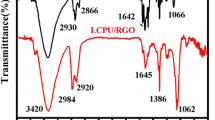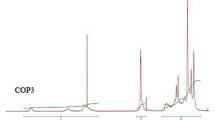Abstract
The polymer composites were prepared based on the incorporation of graphene particles in various ratios to lacton ended poly(benzyl methacrylate) (LE-PBMA). The thermal caharacterization of composites was performed by DSC and TGA techniques. The dielectric constant (ε′), the dielectric loss factor (ε″) and the ac and dc conductivities (σac and σdc) were measured using an impedance analyzer in a frequency range from 100 to 2 kHz. The thermal degradation up to 500 °C under vacuum of LE-PBMA loaded with 12 w% graphene was investigated. Thermal degradation was carried out to known if the addition of graphene causes any changes in the degradation processes of LE-PBMA/graphene 12 w%, and it was compared to that of pure LE-PBMA prepared by ATRP (atom transfer radical polymerization) method. When compared with those of PBMA prepared by free radical polymerization, the trend of depolymerization for LE-PBMA in the presence of graphene in the composite system decreased from 78% (by mol) up to 37% (by mol). The FT-IR, 1H- 13C-NMR and GC–MS data showed that depolymerization corresponding to monomer (benzyl methacrylate) was the most important product trapped at CRF (cold ring fraction) in the thermal degradation of composite.




















Similar content being viewed by others
References
Winey KI, Vaia RA (2007) Polymer nanocomposites. MRS Bull 32(4):314–322. https://doi.org/10.1557/mrs2007.229
A.Geim, K. Novoselov (2010), The rise of graphene, nanoscience and technology:a collection of reviews from nature journals, World Sci, 11–19. https://doi.org/10.1142/9789814287005_0002.
Stankovich S, Dikin DA, Dommett GH, Kohlhaas KM, Zimney EJ, Stach EA, Piner RD, Nguyen ST, Ruoff RS (2006) Graphene-based composite materials. Nature 442(7100):282–286. https://doi.org/10.1038/nature04969
Chiu F-C, Chen Y-J (2015) Evaluation of thermal, mechanical, and electrical properties of PVDF/GNP binary and PVDF/PMMA/GNP ternary nanocomposites. Compos A Appl Sci Manuf 68:62–71. https://doi.org/10.1016/j.compositesa.2014.09.019
Yu S, Li N, Higgins D, Li D, Li Q, Xu H, Spendelow JS, Wu G (2014) Self-assembled reduced graphene oxide/polyacrylamide conductive composite films. ACS Appl Mater Interfaces 6(22):19783–19790. https://doi.org/10.1021/am504941p
Zhang H-B, Zheng W-G, Yan Q, Yang Y, Wang J-W, Lu Z-H, Ji G-Y, Yu Z-Z (2010) Electrically conductive polyethylene terephthalate/graphene nanocomposites prepared by melt compounding. Polymer 51(5):1191–1196. https://doi.org/10.1016/J.Polymer.2010.01.027
Wang Z, Han NM, Wu Y, Liu X, Shen X, Zheng Q, Kim J-K (2017) Ultrahigh dielectric constant and low loss of highly-aligned graphene aerogel/poly (vinyl alcohol) composites with insulating barriers. Carbon 123:385–394. https://doi.org/10.1016/j.carbon.2017.07.079
Liang J, Wang Y, Huang Y, Ma Y, Liu Z, Cai J, Zhang C, Gao H, Chen Y (2009) Electromagnetic interference shielding of graphene/epoxy composites. Carbon 47(3):922–925. https://doi.org/10.1016/j.-carbon.2008.12.038
Pandey JK, Reddy KR, Kumar AP, Singh R (2005) An overview on the degradability of polymer nanocomposites. Polym Degrad Stab 88(2):234–250. https://doi.org/10.1016/j.polymdegradstab.2004.09.013
P.M. Visakh and O.B. Nazarenko, Thermal degradation of polymer blends, composites and nanocomposites, Thermal Degradation of Polymer Blends, Composites and Nanocomposites, Springer2015, pp. 1–16. DOI https://doi.org/10.1007/978-3-319-03464-5_1.
Sahoo NG, Rana S, Cho JW, Li L, Chan SH (2010) Polymer nanocomposites based on functionalized carbon nanotubes. Prog Polym Sci 35(7):837–867. https://doi.org/10.1016/j.progpolymsci.2010.03.002
Peterson JD, Vyazovkin S, Wight CA (2001) Kinetics of the thermal and thermo-oxidative degradation of polystyrene, polyethylene and poly(propylene). Macromol Chem Physic 202(6):775–784
Demirelli K, Coskun M, Kaya E (2004) Polymers based on benzyl methacrylate: Synthesis via atom transfer radical polymerization, characterization, and thermal stabilities. J Polym Sci, Part A: Polym Chem 42(23):5964–5973. https://doi.org/10.1002/pola.20447
Kim H, Abdala AA, Macosko CW (2010) Graphene/polymer nanocomposites. Macromolecules 43(16):6515–6530. https://doi.org/10.1021/ma100572e
Chrissafis K, Bikiaris D (2011) Can nanoparticles really enhance thermal stability of polymers? Part I: an overview on thermal decomposition of addition polymers. Thermochim Acta 523(1–2):1–24. https://doi.org/10.1016/j.tca.2011.06.010
Vassiliou A, Chrissafis K, Bikiaris D (2010) Thermal degradation kinetics of in situ prepared PET nanocomposites with acid-treated multi-walled carbon nanotubes. J Therm Anal Calorim 100(3):1063–1071. https://doi.org/10.1007/s10973-009-0426-4
Chrissafis K, Paraskevopoulos KM, Papageorgiou GZ, Bikiaris DN (2008) Thermal and dynamic mechanical behavior of bionanocomposites: fumed silica nanoparticles dispersed in poly (vinyl pyrrolidone), chitosan, and poly (vinyl alcohol). J Appl Polym Sci 110(3):1739–1749. https://doi.org/10.1002/app.28818
Mandal DK, Bhunia H, Bajpai PK (2019) Thermal degradation kinetics of PP/PLA nanocomposite blends. J Thermoplast Compos Mater 32(12):1714–1730. https://doi.org/10.1177/0892705718805130
Xie W, Gao Z, Pan W-P, Hunter D, Singh A, Vaia R (2001) Thermal degradation chemistry of alkyl quaternary ammonium montmorillonite. Chem Mater 13(9):2979–2990
Qin H, Zhang Z, Feng M, Gong F, Zhang S, Yang M (2004) The influence of interlayer cations on the photo-oxidative degradation of polyethylene/montmorillonite composites. J Polym Sci, Part B: Polym Phys 42(16):3006–3012. https://doi.org/10.1002/polb.20068
Wang S, Ouyang X, Feng Z, Cao Y, Gu M, Li X (2018) [Opto-Electron Adv, 2018, 1 (2)] Diffractive photonic applications mediated by laser reduced graphene oxides. Opto-Electronic Rep 2(03):a201902002. https://doi.org/10.29026/oea.2018.170002
Zhao X, Zhang Q, Chen D, Lu P (2010) Enhanced mechanical properties of graphene-based poly (vinyl alcohol) composites. Macromolecules 43(5):2357–2363
Ramesh S, Ang G (2010) Impedance and FTIR studies on plasticized PMMA–LiN (CF 3 SO 2) 2 nanocomposite polymer electrolytes. Ionics 16(5):465–473. https://doi.org/10.1007/s11581-009-0417-2
Gajula GR, Kumar KC, Buddiga LR, Nethala GP (2018) Dielectric and impedance properties of Li0.5Fe2,5SO4 doped BaTiO3 composite ceramics. Results Phys 11:899–904. https://doi.org/10.1016/j.rinp.2018.10.057
Reddy TG, Kumar BR, Rao TS, Ahmad JA (2011) Structural and dielectric properties of barium bismuth titanate (BaBi4Ti4O15) ceramics. Int J Appl Eng Res 6(5):571–580
Upadhyay S, Sahu AK, Kumar D, Parkash O (1998) Probing electrical conduction behavior of BaSnO3. J Appl Phys 84(2):828–832. https://doi.org/10.1063/1.368143
Prasad K, Suman CK, Choudhary RNP (2006) Electrical characterisation of Pb2Bi3SmTi5O18 ceramic using impedance spectroscopy. Adv Appl Ceram 105(5):258–264. https://doi.org/10.1179/174367606X115940
E. Pretsch, T. Clerc, J. Seibl, W. Simon, Tables of spectral data for structure determination of organic compounds, Springer Science & Business Media 2013.
Lin S-Y, Cheng W-T, Wei Y-S, Lin H-L (2011) DSC-FTIR microspectroscopy used to investigate the heat-induced intramolecular cyclic anhydride formation between Eudragit E and PVA copolymer. Polym J 43(6):577–580. https://doi.org/10.1038/pj.2011.15
Demirelli K, Coşkun M, Kaya E (2001) A detailed study of thermal degradation of poly(2-hydroxyethyl methacrylate). Polym Degrad Stab 72(1):75–80. https://doi.org/10.1016/S0141-3910(00)00204-4
Ho BC, Lee YD, Chin WK (1992) Thermal degradation of polymethacrylic acid. J Polym Sci, Part A: Polym Chem 30(11):2389–2397. https://doi.org/10.1002/pola.1992.080301113
Coşkun MF, Demirelli K, Coşkun M, Doǧru M (2002) Thermal decomposition of poly[3-phthalimido-2-hydroxypropyl methacrylate]. Polym Degrad Stab 76(1):145–154. https://doi.org/10.1016/S0141-3910(02)00008-3
McNeill IC, Ahmed S, Memetea L (1995) Thermal degradation of vinyl acetate–methacrylic acid copolymer and homopolymers. I. An FTIR spectroscopic investigation of structural changes in the degrading material. Polym Degrad Stab 47(3):423–433. https://doi.org/10.1016/0141-3910(95)00001-1
McNeill IC, Liggat JJ (1992) Thermal degradation of styrene-methacrylic acid copolymers. Polym Degrad Stab 36(3):291–299. https://doi.org/10.1016/0141-3910(92)90069-H
Manring LE (1991) Thermal degradation of poly(methyl methacrylate). 4. Random side-group scission. Macromolecules 24(11):3304–3309. https://doi.org/10.1021/ma00011a040
Demirelli K, Kaya E, Coşkun M (2006) Polymers based on phenyl methacrylate: synthesis via atom transfer radical polymerization, characterization, monomer reactivity ratios, and thermal stabilities. Polym Eng Sci 50(2):268–277. https://doi.org/10.1002/app.22694
Acknowledgements
The authors thank to the Firat University Research Fund for financial support to this Project (FUBAP, FF.19.25).
Author information
Authors and Affiliations
Corresponding author
Additional information
Publisher's Note
Springer Nature remains neutral with regard to jurisdictional claims in published maps and institutional affiliations.
Rights and permissions
About this article
Cite this article
Demirelli, K., Abubakar, A.M., Ahmad, A.A. et al. The effect of end group and graphene on dielectric properties and thermal degradation of poly(benzyl methacrylate) prepared by ATRP method. Polym. Bull. 80, 279–307 (2023). https://doi.org/10.1007/s00289-021-04003-2
Received:
Revised:
Accepted:
Published:
Issue Date:
DOI: https://doi.org/10.1007/s00289-021-04003-2




